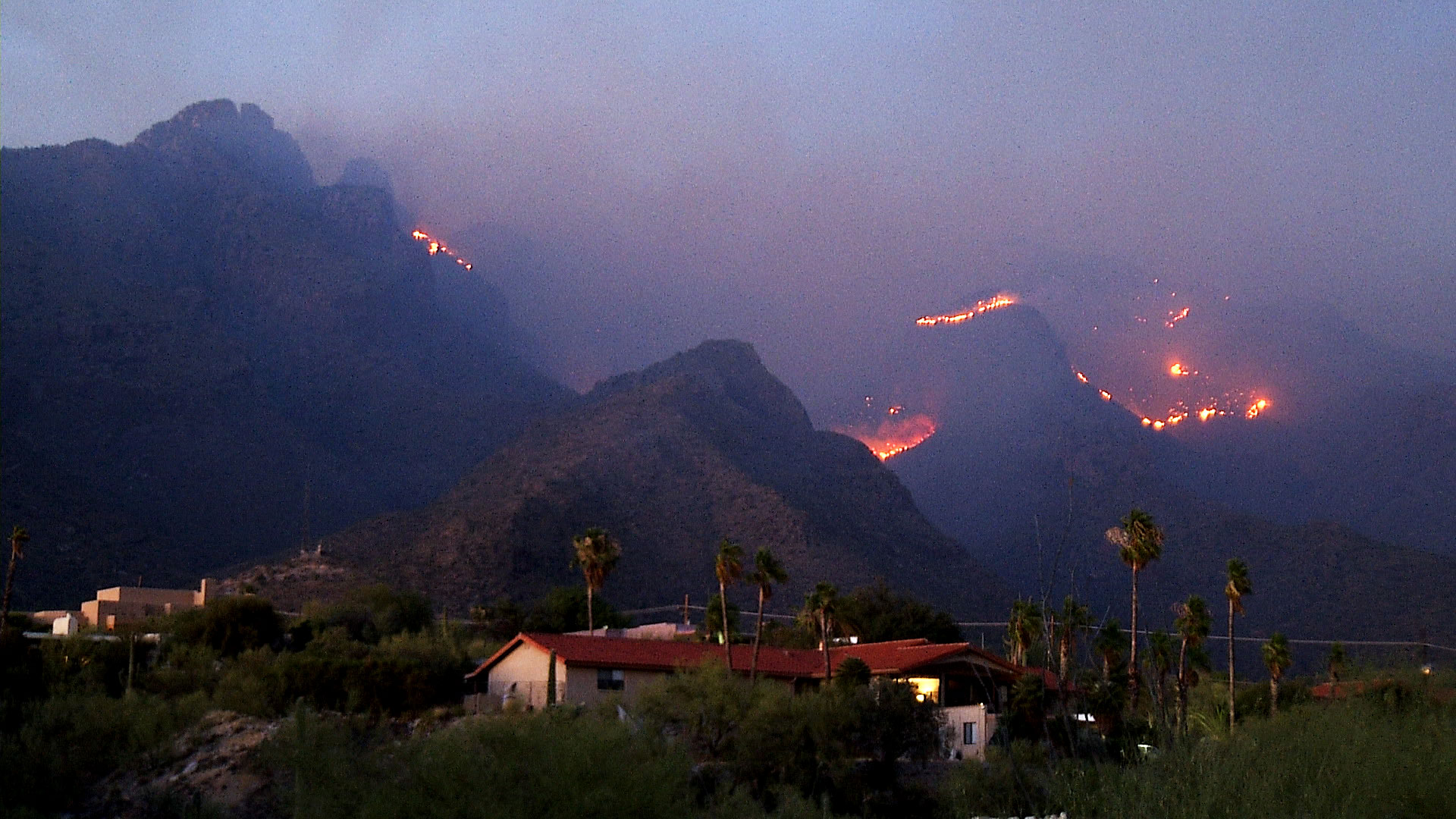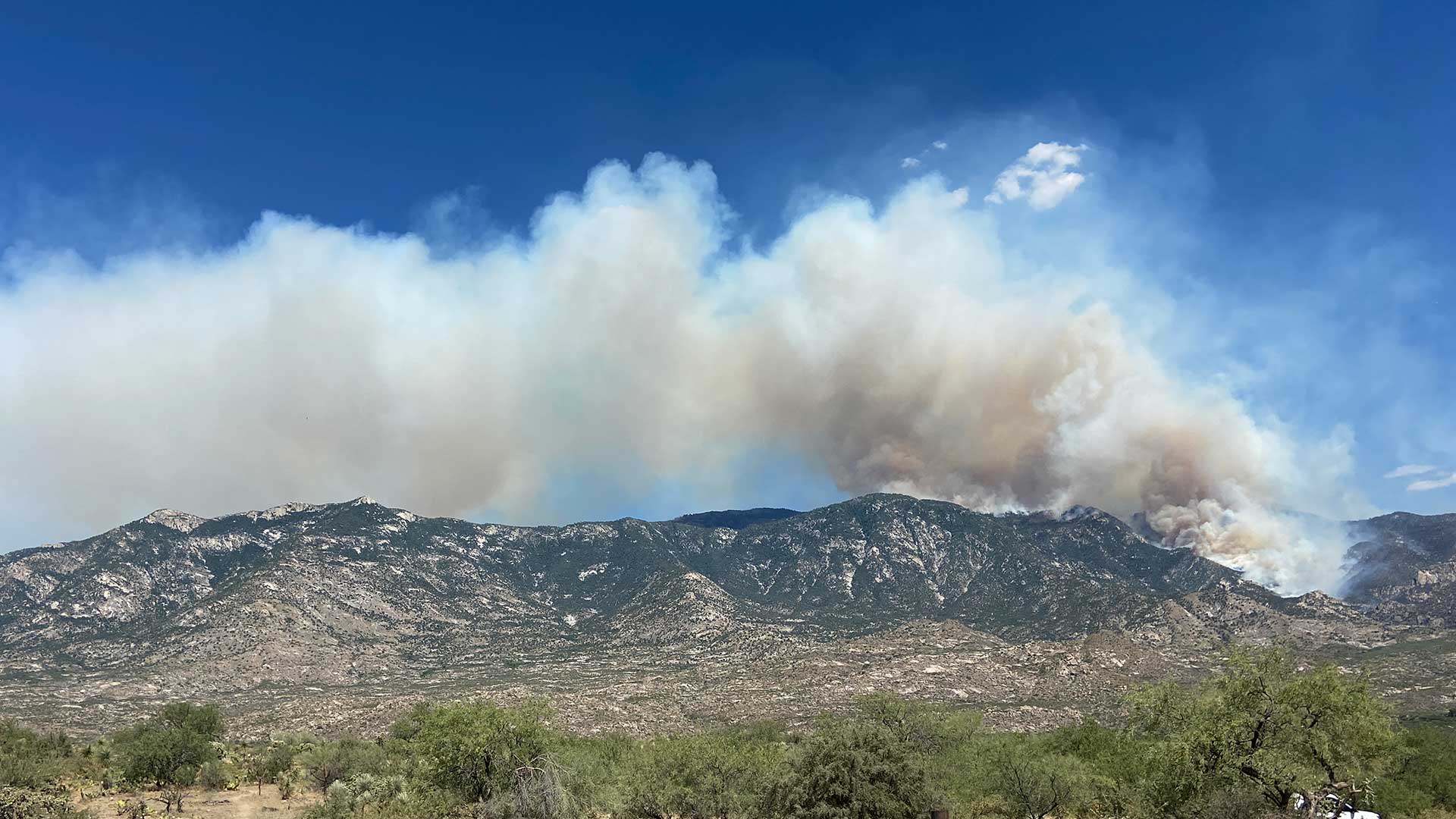 With residences in the foreground, the Bighorn Fire burns in the Santa Catalina Mountains on June 10, 2020.
With residences in the foreground, the Bighorn Fire burns in the Santa Catalina Mountains on June 10, 2020.
Arizona wildfires

The Bighorn Fire has been burning for three weeks in the Santa Catalina Mountains north of Tucson. Molly Hunter, the public information officer on the fire, said it has been a tough fire to fight because of the rocky terrain and proximity to houses on the edge of town.
"The last team that was assigned to the fire, they estimated there were 81 miles of urban interface that at some point was threatened by the fire," Hunter told The Buzz.
Due to the difficult landscape, aircraft, including drones, have been instrumental in suppressing and monitoring the fire, Hunter said.
As of Thursday afternoon the fire was approximately 33% contained, according to the Arizona Emergency Information Network. Hunter said that these numbers are an estimate of the portion the fire’s perimeter that is under control and will not spread further.
“What has happened is that the fire has grown. As it grows, the percentage of containment, which is really just a mathematical equation, that can fluctuate,” Hunter said.
The Bighorn Fire is not the only large blaze burning in Arizona right now. Kelly Castillo, state fire management officer with the Bureau of Land Management, told The Buzz the wet winter and spring set up conditions for lots of grass and non-native species that burn easily.
While some ecosystems may benefit from occasional wildfires and planned burns, Castillo said the Sonoran Desert is not one of them.
“That is not a fire-dependent ecosystem,” Castillo said. “Any fire in the Sonoran Desert we want to try to avoid.”
Though the monsoon later in the summer can bring relief in the form of rain, it can also cause lightning, which can lead to additional fires. Castillo said 85% of the fires so far this year have been caused by human activity. The Bighorn Fire was started by lightning.
 Smoke billows from the Bighorn Fire, June 16, 2020.
Smoke billows from the Bighorn Fire, June 16, 2020.
For the last few weeks, Tucson residents have seen clouds of smoke hanging over the city and Santa Catalina Mountains. Wildfire smoke doesn’t just look menacing, it can also be harmful to your health.
According to the Centers for Disease Control and Prevention, smoke inhalation can result in coughing, wheezing and irritation in the eyes, throat and nose. Smoke inhalation can also cause headaches and asthma attacks.
The best way to minimize health impacts is to avoid exposure to smoke. Beth Gorman is the senior program manager of the Pima County Department of Environmental Quality, which has been monitoring the effects of the Bighorn Fire on local air quality.
“If you smell smoke, you're breathing it into your lungs,” Gorman said. “And that's what can cause the health effects.”
Pima County residents can check local air quality online. The county updates the site every hour, though Gorman says there are only about a dozen monitoring sites.
The state Department of Environmental Quality recently launched a Wildfire Smoke Forecast. These forecasts also keep track of the size of the fire, wind conditions and recommendations for the level of safe outdoor activity.
For people in smoke-heavy areas, the best move is to stay inside with the windows closed and limit the amount of outside air that comes into the house.
Fire, while potentially damaging to homes and air quality, is a part of the natural environment. Robert Steidl is a professor of wildlife ecology at the University of Arizona. He said the impacts of fire will differ depending on where it's burning. Certain areas, like grasslands, are more fire prone than others. The low desert is particularly unsuited for fires.
With regard to the Bighorn Fire, “what's new here is the fire starting down low,” Steidl said.
Invasive species like buffelgrass can contribute to more frequent fires because it grows in dense clusters, making it convenient fire fuel, Steidl said. Native species, like saguaro cacti, are not adapted to handle fire well.
Many animal species in the Sonoran Desert spend the day underground in the middle of summer. If they're lucky, this could potentially help them avoid mortality due to fire, said Steidl. But once they emerge, the landscape may look drastically different. And that can lead to changes in which species thrive.
“After a fire is through, does it still provide what those species need to persist?” Steidl said.



By submitting your comments, you hereby give AZPM the right to post your comments and potentially use them in any other form of media operated by this institution.